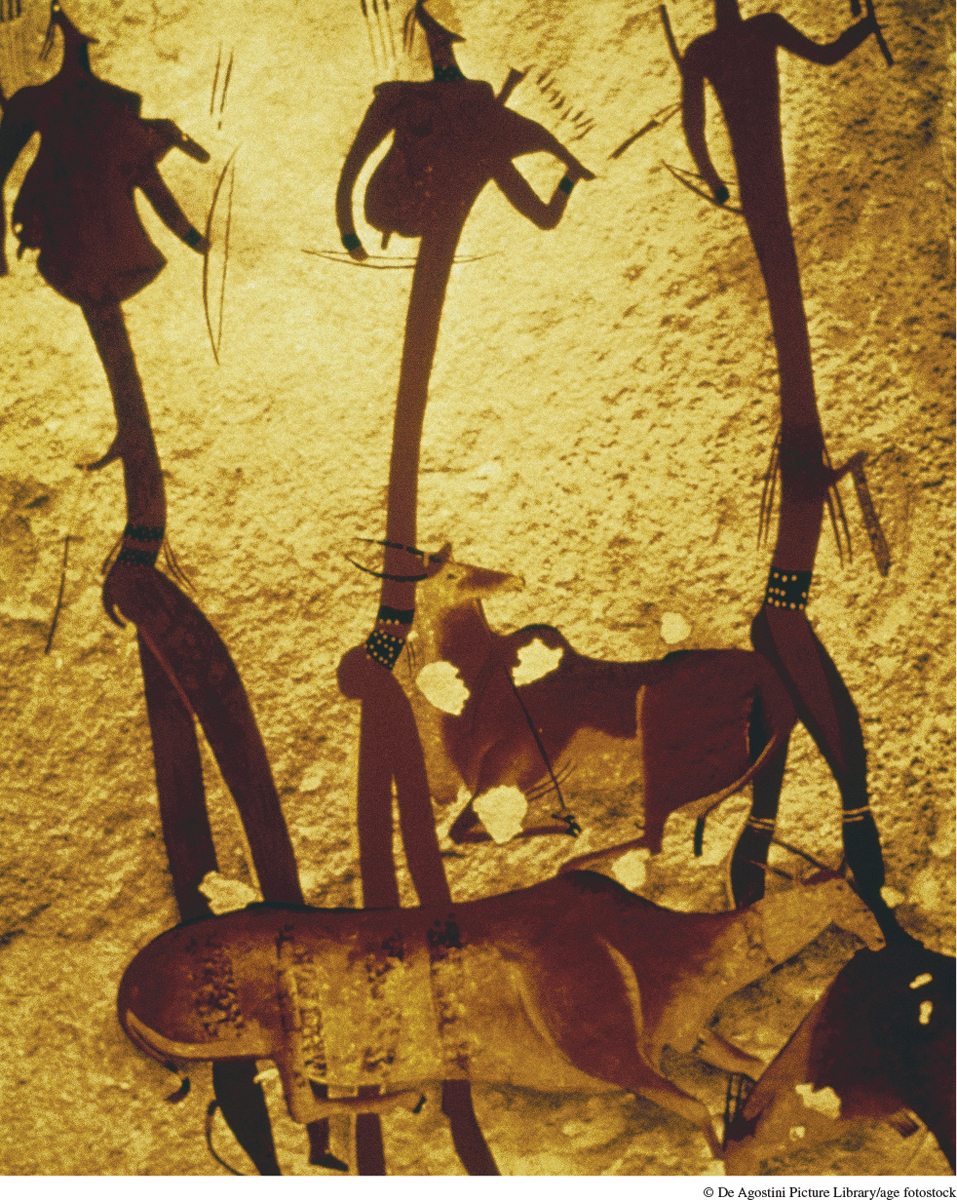Introduction to Chapter 1
CHAPTER 1
First Peoples; First Farmers
Most of History in a Single Chapter to 4000 B.C.E.

“We do not want cattle, just wild animals to hunt and water that we can drink.”1 That was the view of Gudo Mahiya, a prominent member of the Hadza people of northern Tanzania, when he was questioned in 1997 about his interest in a settled life of farming and cattle raising. The Hadza represent one of the very last peoples on earth to continue a way of life that was universal among humankind until 10,000 to 12,000 years ago. In 2014, only about 1,300 Hadza survived, and of these just several hundred still made a living by hunting game, collecting honey, digging up roots, and gathering berries and fruit. Those few lived in quickly assembled grass huts located in small mobile camps averaging eighteen people and moved frequently around their remote region, following animal migrations. Almost certainly, their way of life is doomed, as farmers, cattle herders, governments, missionaries, and now tourists push them toward extinction. The likely disappearance of their culture is among the final chapters of a very long story in which gathering, hunting, and fishing peoples have been unsuccessfully on the defensive against more numerous and powerful neighbors for 10,000 years.
N onetheless, that way of life sustained humankind for more than 95 percent of the time that our species has inhabited the earth. During countless centuries, human beings successfully adapted to a wide variety of environments without benefit of deliberate farming or animal husbandry. Instead, our early ancestors wrested a livelihood by gathering wild foods such as berries, nuts, roots, and grain; by scavenging dead animals; by hunting live animals; and by fishing. Known to scholars as “gathering and hunting” peoples, they were foragers or food collectors rather than food producers. Because they used stone rather than metal tools, they also have been labeled “Paleolithic,” or “Old Stone Age,” peoples.
Then, around 12,000 years ago, an enormous transformation began to unfold as a few human societies — in Eurasia, Africa, and the Americas alike — started to practice the deliberate cultivation of plants and the domestication of animals. This Agricultural or Neolithic (New Stone Age) Revolution marked a technological breakthrough of immense significance, with implications for every aspect of human life. This chapter, then, dealing with the long Paleolithic era and the initial transition to an agricultural way of life, represents most of human history — everything, in fact, before the advent of urban-based civilizations, which began around 5,500 years ago.
And yet history courses and history books often neglect this long phase of the human journey and instead choose to begin the story with the early civilizations of Egypt, Mesopotamia, China, and elsewhere. Some historians identify “real history” with writing and so dismiss the Paleolithic and Neolithic eras as largely unknowable because their peoples did not write. Others, impressed with the rapid pace of change in human affairs in more recent times, assume that nothing much of real significance happened during the long Paleolithic era — and that no change meant no history.
But does it make sense to ignore the first 200,000 years or more of human experience? Although written records are absent, scholars have learned a great deal about Paleolithic and Neolithic peoples through their material remains: stones and bones, fossilized seeds, rock paintings and engravings, and much more. Archeologists, biologists, botanists, demographers, linguists, and anthropologists have contributed much to our growing understanding of gathering and hunting peoples and early agricultural societies. Furthermore, the achievements of Paleolithic peoples — the initial settlement of the planet, the creation of the earliest human societies, the beginnings of reflection on the great questions of life and death — surely deserve our attention. And the breakthrough to agriculture arguably represents the single most profound transformation of human life in all of history. The changes wrought by our early ancestors, though far slower than those of more recent times, were extraordinarily rapid in comparison to the transformation experienced by any other species. Those changes were almost entirely cultural or learned, rather than the product of biological evolution, and they provided the foundation on which all subsequent human history was constructed. Our grasp of the human past is incomplete — massively so — if we choose to disregard the Paleolithic and Neolithic eras.
| A MAP OF TIME (All dates B.P.: Before the Present) | |
|---|---|
| 250,000–200,000 | Earliest Homo sapiens in Africa |
| 100,000–60,000 | Beginnings of migration out of Africa |
| 70,000 | Human entry into eastern Asia |
| 60,000–40,000 | Human entry into Australia (first use of boats) |
| 45,000 | Human entry into Europe |
| 30,000 | Extinction of large mammals in Australia |
| 30,000–15,000 | Human entry into the Americas |
| 30,000–17,000 | Cave art in Europe |
| 25,000 | Extinction of Neanderthals |
| 16,000–10,000 | End of last Ice Age (global warming) |
| 12,000–10,000 | Earliest agricultural revolutions |
| 11,000 | Extinction of large mammals in North America |
| After 8,000 | First chiefdoms in Mesopotamia |
| 6,000–5,000 | Beginning of domestication of corn in southern Mexico |
| 3,500–1,000 | Austronesian migration to Pacific islands and Madagascar |
| 1,000–800 | Human entry into New Zealand (last major region to receive human settlers) |
SEEKING THE MAIN POINT
What arguments does this chapter make for paying serious attention to human history before the coming of “civilization”?